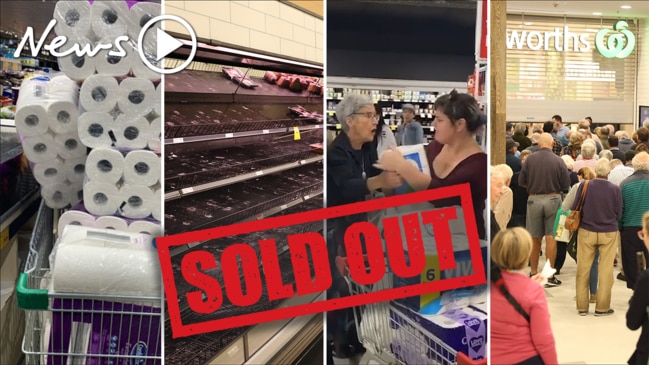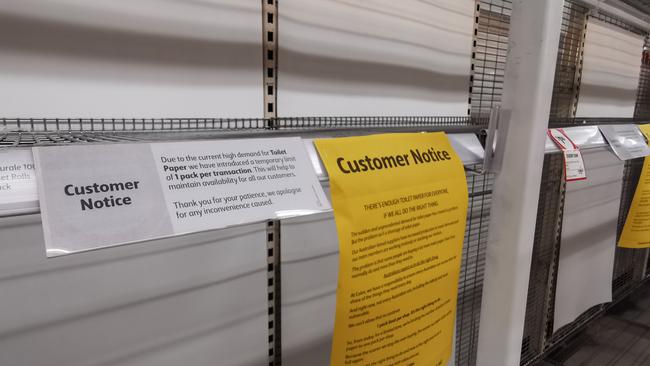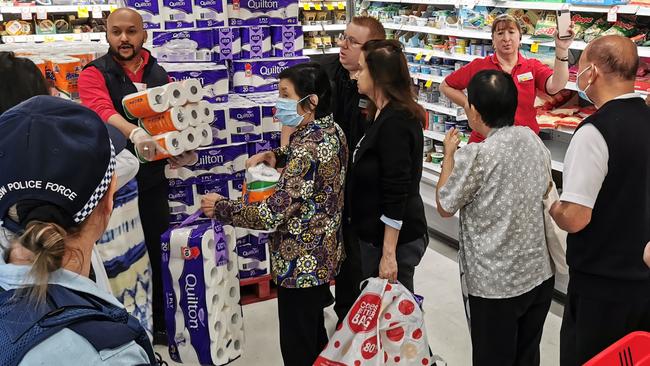Are you one of the nation’s panic buyers? Nationally 6 per cent of shoppers are ‘rampant stockpilers’
When it comes to panic-buying, not everyone is doing it and not all states are equal. A new study reveals the states where the worst offenders are. Spoiler alert: South Aussies are comparably pretty good!

Coronavirus News
Don't miss out on the headlines from Coronavirus News. Followed categories will be added to My News.
A study of Aussies shoppers this week has found just one in 16 of us have rampantly stockpiled with the majority of buyers in this state only getting what has been needed.
Research firm McCrindle has surveyed 1015 shoppers across the nation for a snapshot of sentiments and attitudes and to find what is driving the COVID-19 shopping aisle behaviour.
Lead social researcher Mark McCrindle says the infield work reveals just a small minority of Australians have driven the panic buying trend.
“It means ordinary people cannot buy what they now need, including the most vulnerable – two in three Australians (66 per cent) have been unable to buy goods they’ve needed,” Mr McCrindle said.
“That single digit figure (six per cent) of Australians has caused a rippling effect, creating the shortages in the aisles and that it is quite remarkable – it’s this small proportion of shoppers who has had an asymmetric impact on the broader public.
“We had six per cent who went out and bulk bought in an intentional, strategic way and this prompted another 30 per cent to start stockpiling because they saw the supermarkets becoming bare, creating the problems we are still seeing.
“The stockpilers have gone in pretty hard, they’ve gone not just to their local store but from store to store, resulting in something that used to be such a normal activity becoming a high pain point for the majority of Australians – this contagion of panic buying has spread outside the metropolitan areas into regional parts as well.”

Interestingly, Mr McCrindle says, when participants were asked to sum up their views on bulk buying it was again almost six per cent who opted for the option, “I think people should be able to buy as much as they want”.
But nationally, one in three believe people “should show self-restraint”.
In SA, almost half the shoppers surveyed (47 per cent) said they believed people should show restraint in the shopping aisles, compared to 26 per cent in Victoria, 30 per cent in Queensland and 34 per cent in New South Wales.
“The data shows greater social etiquette taking place in SA with more self-restraint and less panic buying, above the sharp elbows of Sydneysider and Melbournites,” Mr McCrindle said.
Half of South Aussies (51 per cent) surveyed said they’d bought the same as usual while just over 13 per cent said they hadn’t been able to buy what they normally would.
The survey finds three quarters (74 per cent) of shoppers nationally would be willing to refrain from panic buying to protect the vulnerable in our communities, the issue is supply.
MORE STORIES:
We pick the best of humanity on show in Adelaide amid COVID-19
When participants were asked how long they believed the coronavirus crisis would last, two in five (just over 40 per cent) predicted it would be at least seven months.
A quarter of respondents tipped it would be between seven months and a year before “things to get back to normal” while 12 per cent say it will be one to years.
One in 20 people believe it will take more than two years.

A national snapshop of shoppers’ habits
TWO in three Australians (66 per cent) have been unable to buy goods they’ve needed as a result of the COVID-19 outbreak.
ONLY six per cent of Australians are buying a lot more than they need with 30 per cent buying “a bit more” than they need.
TWO in five (42 per cent ) are buying the same amount as usual but almost a quarter of Australians (23 per cent) haven’t been able to buy as much as they need.
AUSTRALIANS believe people should show self-restraint (32 per cent) and support shops placing limits (38 per cent). Almost a quarter (24 per cent) want the government to intervene on bulk buying.
ALMOST three quarters (74 per cent) would be willing to refrain from panic buying to protect the vulnerable in our communities.
– McCrindle Research
